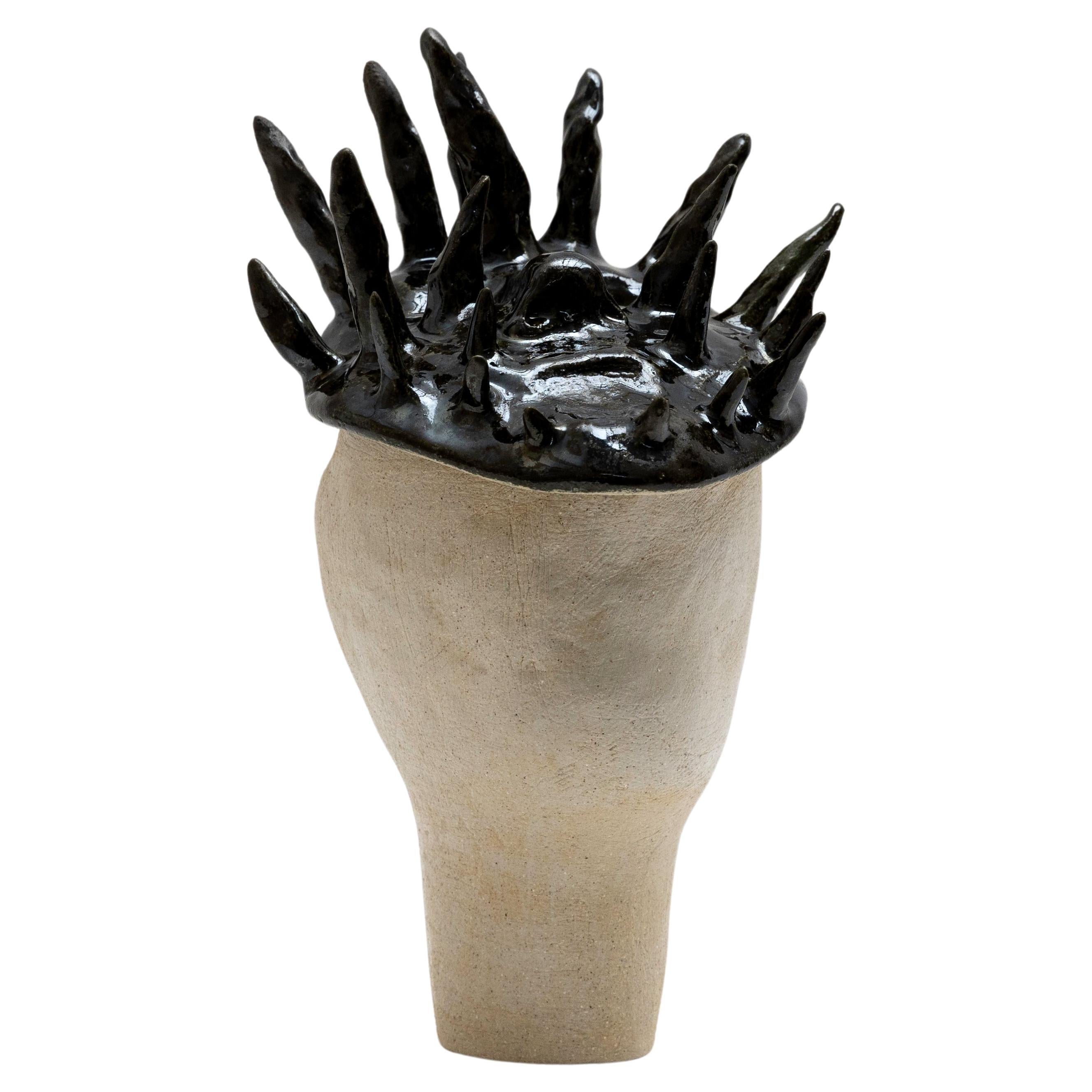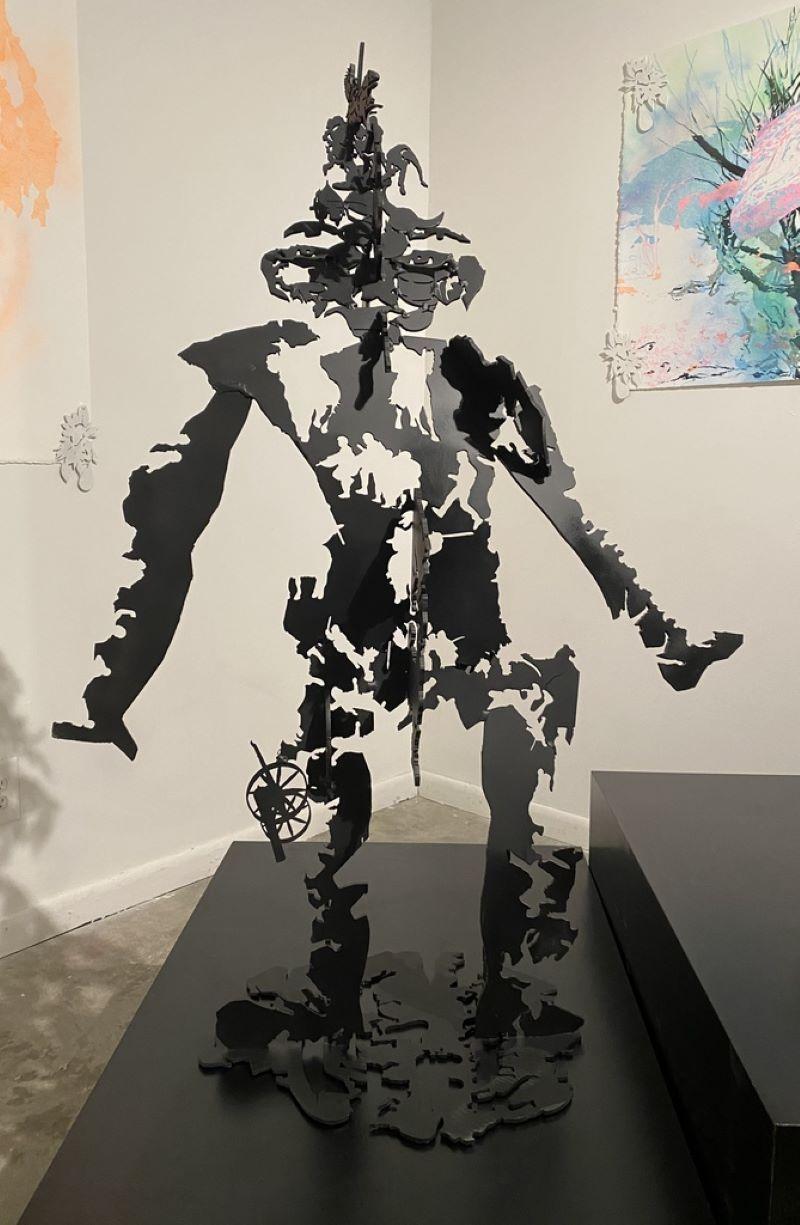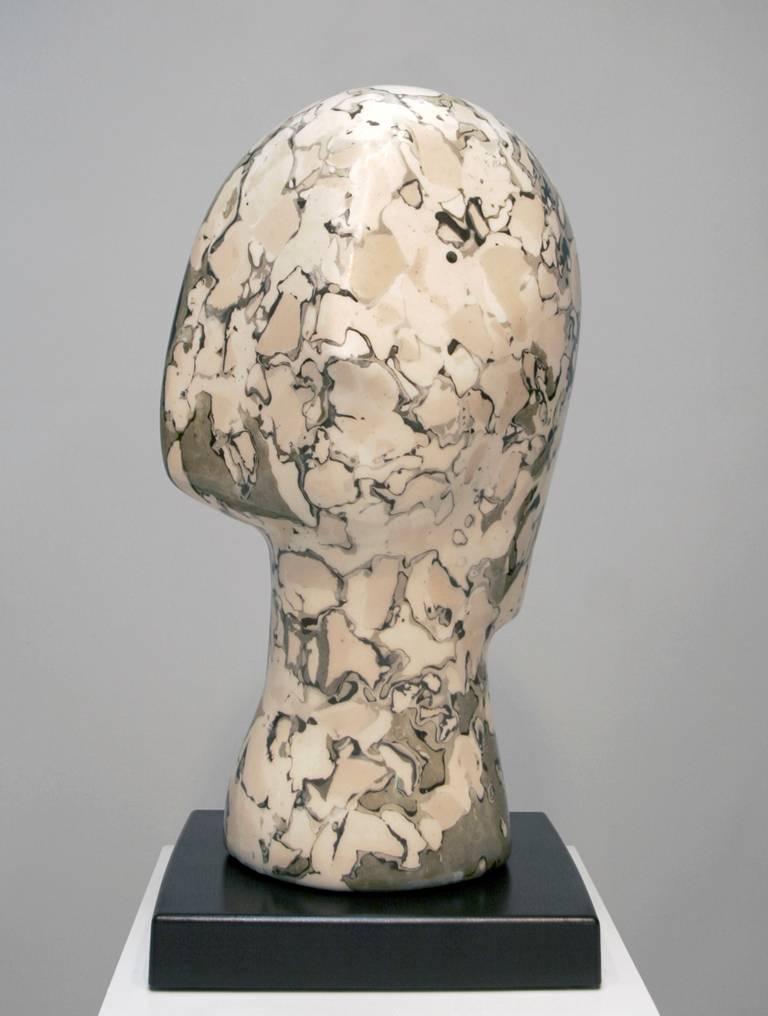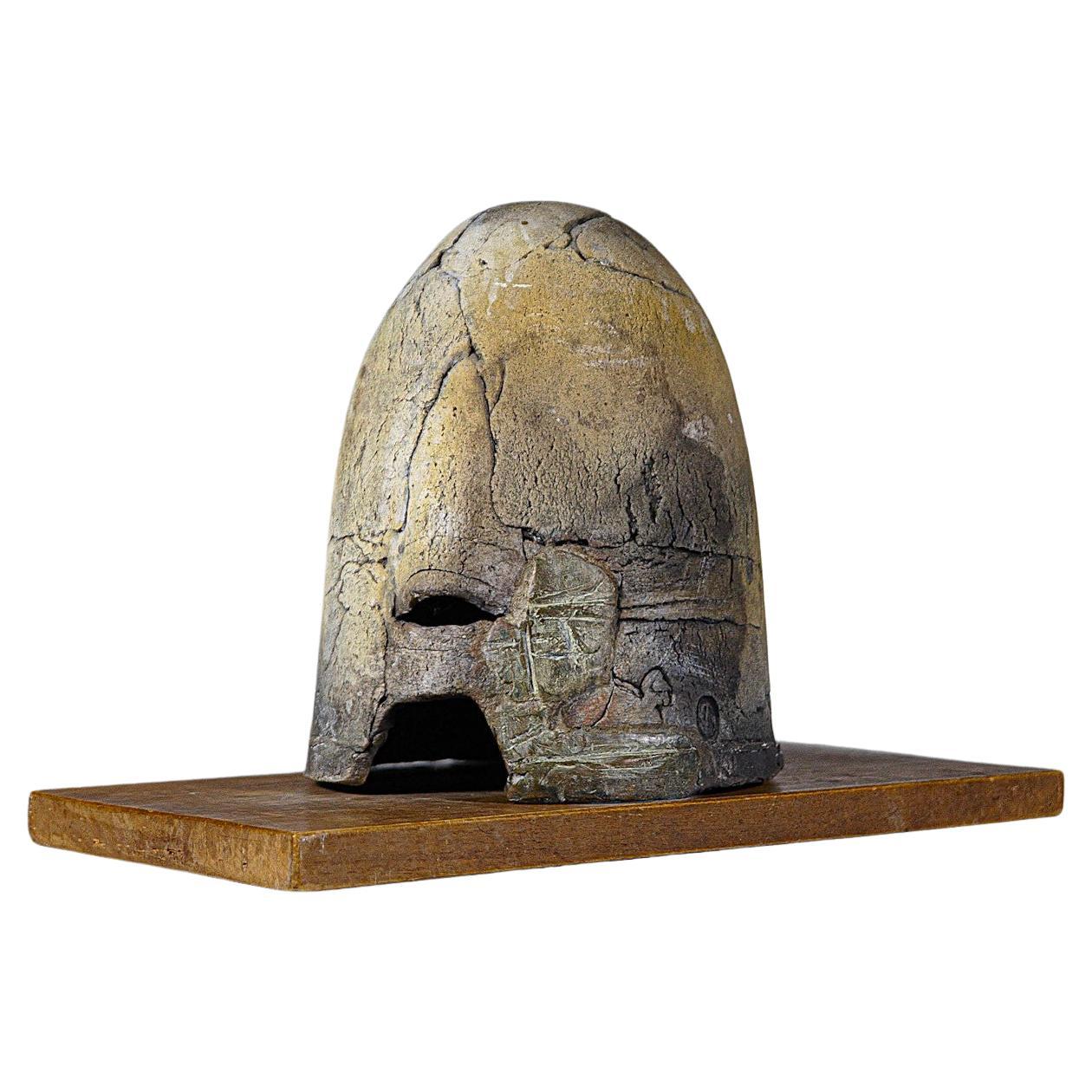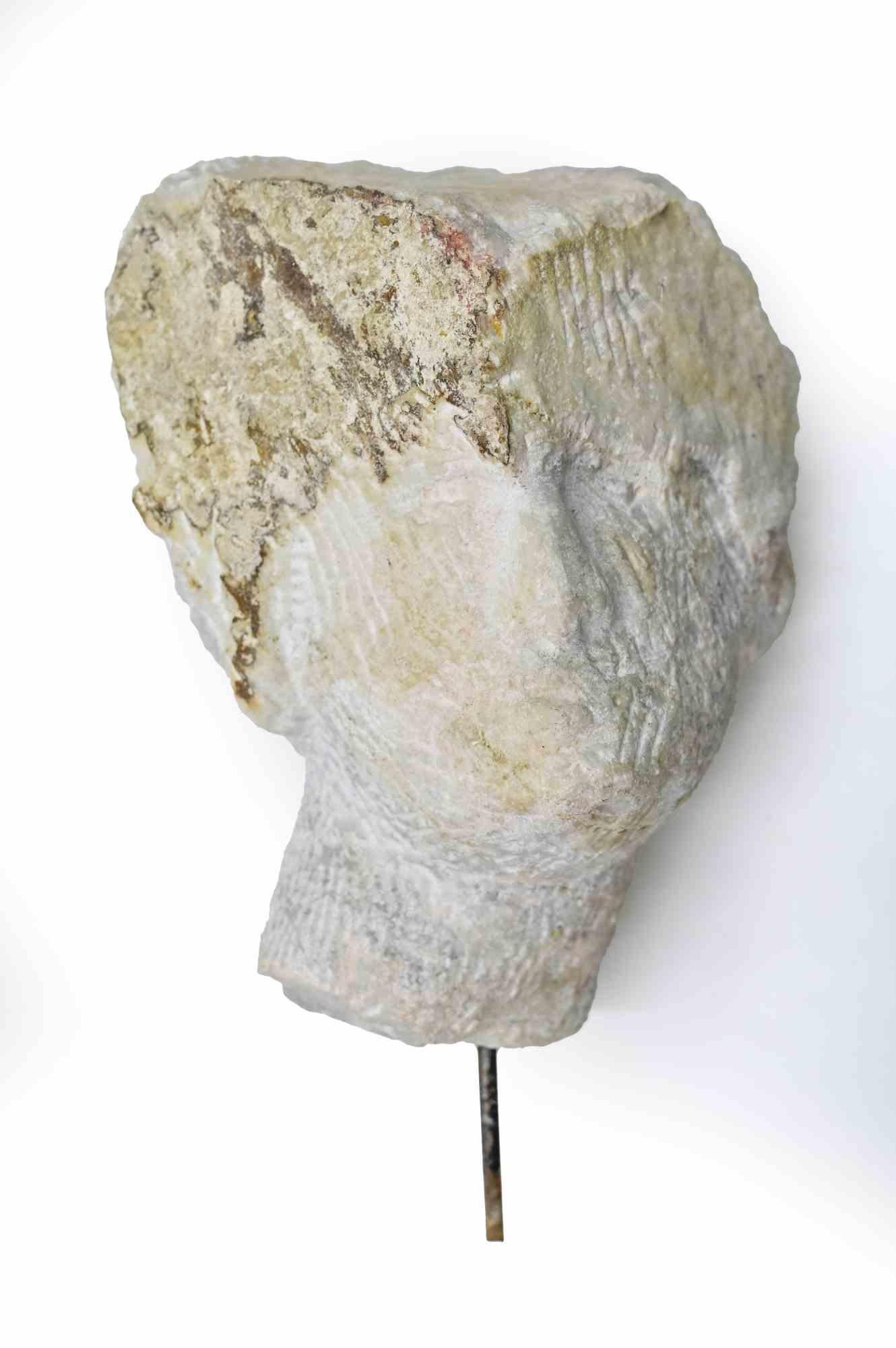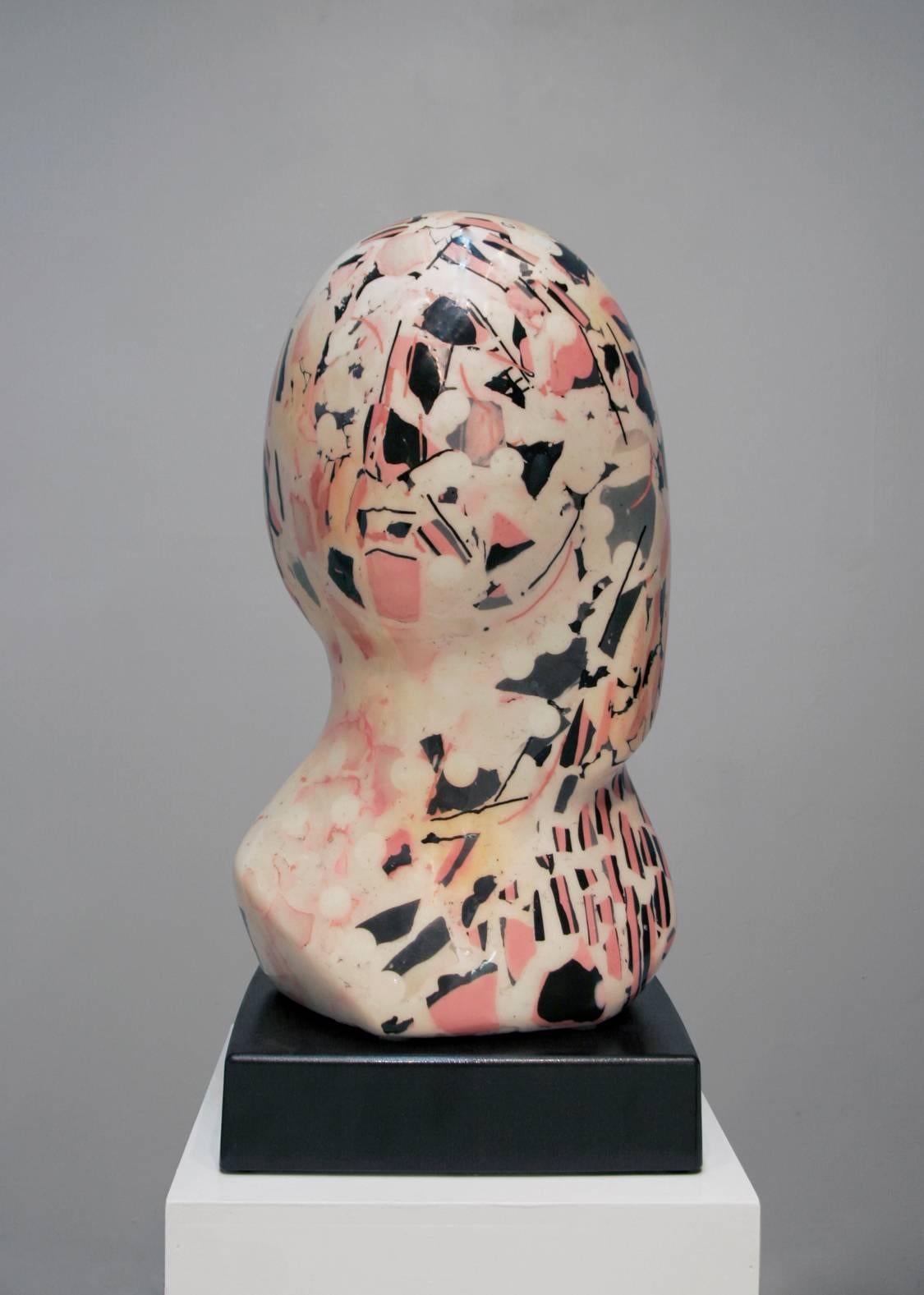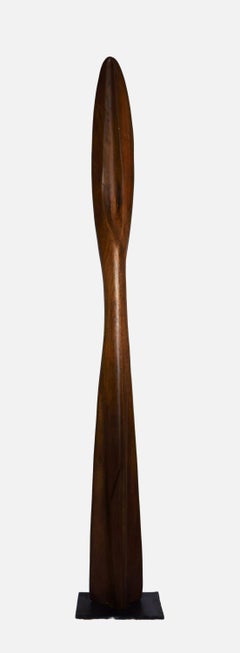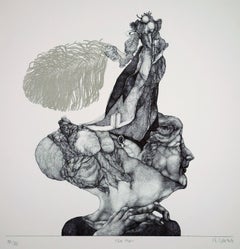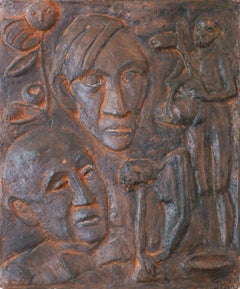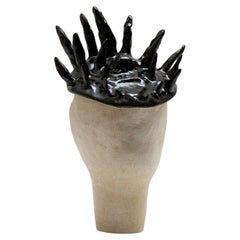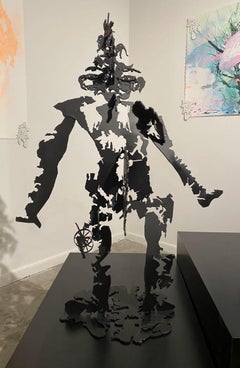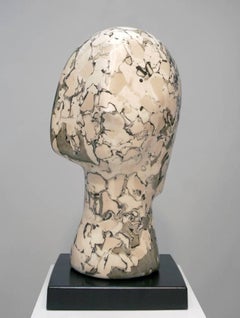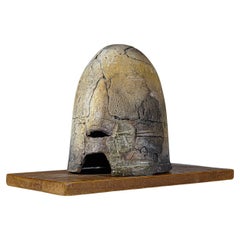Want more images or videos?
Request additional images or videos from the seller
1 of 11
Karl-Heinz DeutschHelmet Head / - Futuristic Archaism -c. 2003
c. 2003
$4,188.46
£3,111.33
€3,500
CA$5,778.27
A$6,351.91
CHF 3,338.27
MX$77,135.35
NOK 41,644.12
SEK 39,454.88
DKK 26,643.81
About the Item
Karl-Heinz Deutsch (*1940 Karlsruhe), Helmet Head, around 2003. Polished and patinated bronze, 23.5 cm (height) x 25.5 cm (length) x 16 cm (depth), weight 4.9 kg. Monogrammed on the reverse, identified as copy number 4/6, and with the foundry mark "Balzer Pforzheim".
- In mint condition.
- Futuristic Archaism -
The helmet head looks like a relic from the archaic past as well as from the future. The dark areas give the impression of having been sculpted in an original way, showing scratches and abrasions caused by the passage of time, while the elegantly curved polished areas, reminiscent of Brancusi's futuristic sculptures, anticipate a time that has not yet dawned. Unlike Brancusi's more abstract figures, however, the anthropomorphic is the essential element in the helmet head. The back of the head, in particular, is clearly contoured and we can make out the eyes, at least on one side, while the polished, golden shimmering surfaces with the curve that runs from the forehead to the chin and the slit-like indentations around the mouth transform the anthropomorphic into something helmet-like. However, despite the different coloration, it is not possible to distinguish between the head and the helmet; rather, the two merge and diverge, as if we were looking at a prototype of the head that is both helmet and head, coming from both the past and the future. The classical effect of the sculpture comes from this timelessness.
The creative exploration of the head is central to Karl-Heinz Deutsch's artistic work, which is why the helmet head is a very important work in the artist's oeuvre, and one that is very rarely offered as a bronze cast on the art market.
"For years I have been preoccupied with the subject of the head and its many design possibilities. It is the dominant feature of the human body. I reduce the figure and concentrate exclusively on it. It stands for the spiritual in man, which is why it has an infinite expressive power for me. In my search for the "primeval head" I find "helmet heads", "axe heads", "visor heads"...".
Karl-Heinz Deutsch
About the artist
After an apprenticeship as a ceramic modeler, which laid the sculptural foundation for his later work as a sculptor, Karl-Heinz Deutsch studied at the Karlsruhe Art Academy from 1960 to 1965 with Hans Kinderman and Fritz Klemm. Since then, he has worked as a freelance artist, with a focus on sculpture in public space, which includes more than 75 realized art-in-architecture projects. For example, he created a silver-plated Janus head for the Rhineland-Palatinate State Representation in Berlin.
Deutsch has also held various public teaching positions since 1965. In 1988 he was appointed honorary professor at the Rhineland-Palatinate University of Applied Sciences. He was the initiator of the international sculpture symposia in Jockgrim. Since 2001, he has had a studio in the Fronte Lamotte of the fortress of Germersheim. An extensive donation by the artist to the city of Germersheim led to the establishment of a sculpture museum, also located in the Fronte Lamotte, which is based on the donation.
Karl-Heinz Deutsch has received several awards and in 2017 was awarded the German Federal Cross of Merit.
GERMAN VERSION
Karl-Heinz Deutsch (*1940 Karlsruhe), Helm-Kopf, um 2003. Polierte und patinierte Bronze, 23,5 cm (Höhe) x 25,5 cm (Länge) x 16 cm (Tiefe), Gewicht 4,9 kg. Rückseitig monogrammiert, als Exemplar Nummer 4/6 ausgewiesen und mit dem Gießereistempel „Balzer Pforzheim“ versehen.
- in tadellosem Zustand
- Futuristische Archaik -
Der Helm-Kopf wirkt gleichermaßen wie ein Relikt aus archaischer Vergangenheit und als ob er aus der Zukunft stammen würde. Die dunklen Partien vermitteln den Eindruck, auf ursprüngliche Weise plastisch geformt worden zu sein und im Lauf der Zeit entstandene Kratzspuren und Abschabungen aufzuweisen, während die elegant geschwungenen an Brancusis futuristische Skulpturen gemahnenden polierten Bereiche eine noch nicht angebrochene Zeit vorwegnehmen. Im Gegensatz zu Brancusis weit abstrakteren Figuren ist das Anthropomorphe beim Helm-Kopf jedoch das wesentliche Moment. Insbesondere der Hinterkopf ist deutlich ausgeformt und wir erkennen – zumindest einseitig – die Augen, während die wie golden schimmernden polierten Flächen mit dem von der Stirn bis zum Kinn durchlaufenden Schwung und den luftschlitzartigen Einkerbungen im Mundbereich das Anthropomorphe zu etwas Helmförmigen transformieren. Allerdings kann, trotz der verschiedenartigen farblichen Erscheinung, nicht zwischen Kopf und Helm unterschieden werden, vielmehr geht beides ineinander über und auseinander hervor, als ob wir einen Prototyp des Kopfes betrachten würden, der Helm und Kopf zugleich ist und gleichermaßen aus der Vergangenheit wie der Zukunft stammt. Aus dieser Überzeitlichkeit resultiert die klassische Wirkung der Skulptur.
Die schöpferische Auseinandersetzung mit dem Kopf ist für Karl-Heinz Deutschs künstlerisches Schaffen zentral, weshalb der Helm-Kopf ein ganz wesentliches Werk im Oeuvre des Künstlers darstellt, der als Bronzeguss nur äußerst selten auf dem Kunstmarkt angeboten wird.
„Seit Jahren beschäftigt mich das Thema „Kopf“ in seiner vielfältigen Gestaltungsmöglichkeit. Er bildet die Dominante des menschlichen Körpers. Dabei reduziere ich die Figur und konzentriere mich ausschließlich auf ihn. Er steht für das Geistige im Menschen, daher hat er für mich unendliche Aussagekraft. Auf der Suche nach dem „Urkopf“ finde ich „Helmköpfe“, „Beilköpfe“, „Visierköpfe“,…“
Karl-Heinz Deutsch
zum Künstler
Nach einer Lehre als Keramik-Modelleur, mit der Karl-Heinz Deutsch die plastischen Grundlagen seiner späteren bildhauerischen Tätigkeit legte, studierte er von 1960 bis 1965 an der Karlsruher Kunstakademie bei Hans Kinderman und Fritz Klemm. Seitdem ist er als freischaffender Künstler tätig, wobei sein hauptsächliches Betätigungsfeld die Skulptur im öffentlichen Raum ist, zu der auch mehr als 75 realisierte Kunst am Bau-Projekte gehören. So schuf er beispielsweise für die Berliner Landesvertretung Rheinland-Pfalz einen versilberten Januskopf.
Seit 1965 geht Deutsch zudem verschiedenen öffentlichen Lehrtätigkeiten nach. 1988 wurde er zum Honorarprofessor der Fachhochschule Rheinland-Pfalz ernannt. Er war Initiator der internationalen Bildhauersymposien in Jockgrim. Seit 2001 betreibt er ein Atelier im Fronte Lamotte der Festung Germersheim. Eine umfangreiche Schenkung des Künstlers an die Stadt Germersheim führte zur Gründung eines ebenfalls im Fronte Lamotte ansässigen Skulpturenmuseums, dessen Grundstock die Schenkung bildet.
Karl-Heinz Deutsch wurde mehrfach ausgezeichnet und 2017 mit dem Bundesverdienstkreuz geehrt.
- Creator:Karl-Heinz Deutsch (1940, German)
- Creation Year:c. 2003
- Dimensions:Height: 9.26 in (23.5 cm)Width: 10.04 in (25.5 cm)Depth: 6.3 in (16 cm)
- Medium:
- Movement & Style:
- Period:
- Condition:
- Gallery Location:Berlin, DE
- Reference Number:1stDibs: LU2438215526192

About the Seller
5.0
Vetted Professional Seller
Every seller passes strict standards for authenticity and reliability
Established in 2014
1stDibs seller since 2023
21 sales on 1stDibs
- ShippingRetrieving quote...Shipping from: Berlin, Germany
- Return Policy
Authenticity Guarantee
In the unlikely event there’s an issue with an item’s authenticity, contact us within 1 year for a full refund. DetailsMoney-Back Guarantee
If your item is not as described, is damaged in transit, or does not arrive, contact us within 7 days for a full refund. Details24-Hour Cancellation
You have a 24-hour grace period in which to reconsider your purchase, with no questions asked.Vetted Professional Sellers
Our world-class sellers must adhere to strict standards for service and quality, maintaining the integrity of our listings.Price-Match Guarantee
If you find that a seller listed the same item for a lower price elsewhere, we’ll match it.Trusted Global Delivery
Our best-in-class carrier network provides specialized shipping options worldwide, including custom delivery.More From This Seller
View AllVegetative Form / - Grown Art -
Located in Berlin, DE
Paul Dierkes (1907 Cloppenburg - 1968 Berlin), Vegetative Form. Mahogany, 1958. 142 x 16 x 10 cm (sculpture), 21 x 17.5 cm (base), monogrammed "PD" on the reverse.
- Grown Art -
...
Category
1950s Post-War Abstract Sculptures
Materials
Mahogany
$3,350 Sale Price
20% Off
The Hut / - The head of the hat -
By Reiner Schwarz
Located in Berlin, DE
Reiner Schwarz (*1940 Hirschberg), The Hut, 1967. Lithograph, 32.5 cm x 32.5 (depiction), 59 cm x 42 cm (sheet size), signed “R.[einer] Schwarz” in pencil lower right, dated “[19]67”...
Category
1960s Surrealist Figurative Prints
Materials
Paper
Homage à Kahnweiler / - The Appearance of Genius-
Located in Berlin, DE
Irmgard Biernath (1905 Waldheim in Saxony - 1998 Mainz), Hommage à Kahnweiler, 1984. Terracotta relief, burnished red body, 43.5 x 38 cm, mounted on support plate, in wooden frame 57 x 49.5 cm, monogrammed "IB" at lower right.
- Isolated patina losses, but overall good condition, frame slightly bumped.
- The Appearance of Genius-
This homage to Daniel-Henry Kahnweiler shows the gallerist and art theorist as Pablo Picasso portrayed him in his lithographic portrait of 1957.
As an innovative Parisian gallery owner, Kahnweiler had exclusively represented Picasso since 1911, while Picasso had painted his famous portrait of Kahnweiler the previous year as a major work of Cubism. And it is Picasso who appears at the centre of Irmgard Biernath's image. Here, his face echoes the features of the self-portrait he painted in 1907 in the Prague National Gallery.
His eyes are wide open as he gazes into the distance, surrounded by the works of his artistic vision that have already taken shape. On the right is the bronze "Man with Sheep...
Category
1980s Contemporary Figurative Sculptures
Materials
Terracotta
$1,148 Sale Price
20% Off
Untitled / - The archaism of nature -
Located in Berlin, DE
Jorge Machold (1940 Chemnitz - 2015 Berlin), Untitled, 1973. Color etching, 41.5 x 29.2 cm (plate size), 49.5 cm x 39.5 cm (sheet size), signed lower right in lead “J.[orge] Machold”...
Category
1970s Abstract Abstract Prints
Materials
Paper
Crusader with shield and mace / - Ready to strike -
Located in Berlin, DE
Josef Moest (1873 Cologne - 1914 Rath), Crusader with shield and mace, around 1910. Bronze on a black marble pedestal (19 cm high). 57.5 cm (total height) x 21 cm (width) x 12 cm (de...
Category
1910s Realist Figurative Sculptures
Materials
Bronze
Rare Animal / - Abstract figuration -
Located in Berlin, DE
Veit Hofmann (*1944 Dresden), Rare Animal, 1987. Oil on light card, 42 cm (height) x 30 cm (width), monogrammed “V[eit]H[ofmann]” lower right and dated “[19]87”, titled “Seltenes Tie...
Category
1980s Abstract Expressionist Abstract Paintings
Materials
Oil
You May Also Like
Mask Sculpture by Eglė Šimkus
Located in Geneve, CH
Mask Sculpture by Eglė Šimkus
Unique Piece.
Dimensions: D 17 x H 29 cm.
Materials: Clay.
My name is Eglė Šimkus, and I was born in Lithuania in 1990 to a ...
Category
2010s French Post-Modern Abstract Sculptures
Materials
Clay
$1,448 / item
Helmet-Head
By Dionisios Fragias
Located in New York, NY
Dionisios Fragias is a New York -based artist born on the Greek island of Kefalonia and raised in New York City. He is the protege of the artist Jeff Koons whose years-long mentorshi...
Category
2010s Naturalistic Abstract Sculptures
Materials
Metal
Price Upon Request
Desiderium Head
By Michael O'Keefe
Located in Dallas, TX
In his sculptures, drawings and paintings, Michael O’Keefe employs unpredictable processes as a means to discover content. He couples accident and chance with unconventional methods, tools, and materials as a means to move beyond the boundaries of his tendencies. In his recent sculptures of heads...
Category
2010s Contemporary Abstract Sculptures
Materials
Plaster, Pigment
A Ceramic Mask Sculpture by Christine Fabre France 2000s
Located in HYÈRES, FR
A primitive ceramic mask by Christine Fabre France early 2000.
Very impressive patina.
Named " Les Veilleurs "
Signed with the stamp of the artist.
In good condition.
Category
Early 2000s French Abstract Sculptures
Materials
Ceramic
Head - Sculpture by Sirio Pellegrini - 1960s
Located in Roma, IT
Stone sculture realized by Sirio Pellegrini in 1960s.
Hand carved.
Good condition.
Sirio Pellegrini, born in Rome on March 1, 1922, of Abruzzo origins (Capestrano), spent his chil...
Category
1960s Modern Figurative Sculptures
Materials
Stone
Agathist Head
By Michael O'Keefe
Located in Dallas, TX
In his sculptures, drawings and paintings, Michael O’Keefe employs unpredictable processes as a means to discover content. He couples accident and chance with unconventional methods,...
Category
2010s Contemporary Sculptures
Materials
Plaster, Pigment
